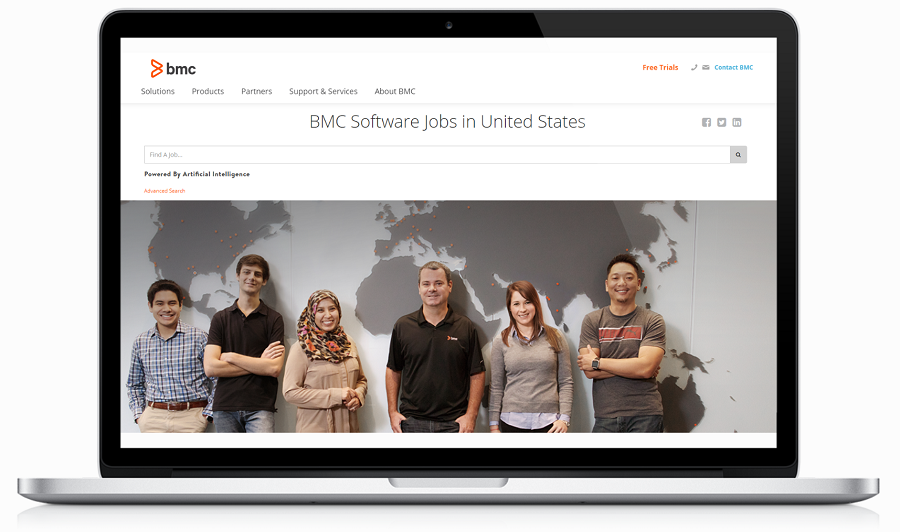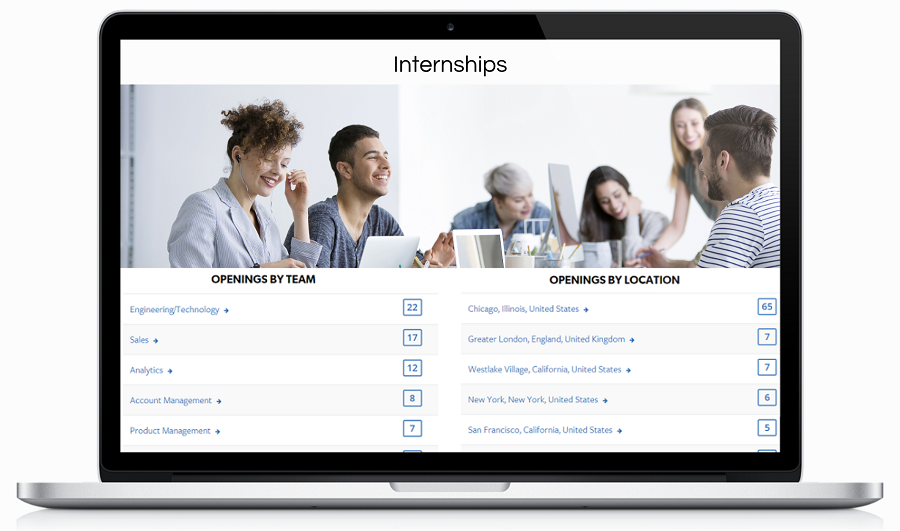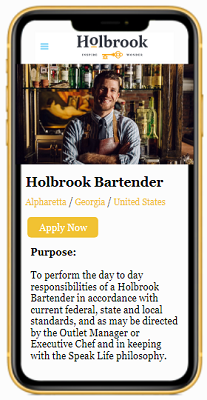- What’s the Difference Between a Job Description, Job Posting, and Job Ad - June 5, 2025
- Top 20+ Diversity Equity Inclusion Titles (with Descriptions) 2024 - October 18, 2024
- A List of Common Offensive (Exclusionary) Words Used in Job Descriptions (2024) - October 18, 2024
It’s no secret that your company career site is one of the most important elements of your recruiting strategy. In fact, it’s a culmination of many initiatives: candidate experience, employer branding, recruitment marketing, diversity and inclusion. So, keep reading this career site guide.
The bottom line: Optimizing your company career site is necessary if you want to attract, engage, and convert more candidates. And it also becomes easier to update it with a career site guide to help you.
And, in this career site guide, I’m going to show you everything you need to build an awesome career site.
Afterall, wouldn’t you love your career site to be included on lists like The 15 Best Career Pages in 2019 or 14 Examples of the Best Company Career Sites (2018)?
7 Key Steps to Creating a New Company Career Site: Career Site Guide
In this career site guide, I’ve included 7 key steps to help you through creating a new career site. However, you might skip one or two based on the size of your company.
My promise: If you follow this career site guide you will jumpstart the progress of your new career site. So, with that, here are the 7 key steps to guide you:
- Step #1: Why Do You Need a New Company Career Site?
- Step #2: Is Your Career Site for a Small or Large Enterprise?
- Step #3: Is Your Career Site Global?
- Step #4: List Your Core Career Site Features
- Step #5: What You’ll Need “Under the Hood” for your Career Site
- Step #6: What Internal Resources do You Have? (CMS?)
- Step #7: Compare Your Internal Resources to a “Recruitment CMS”
1) Career Site Guide: Why Do You Need a New Company Career Site?
A new career site needs a goal to attract potential applicants with the best culture fit. Most Career Site/CMS requests for proposals (RFPs) I read bring up one or more of the following objectives:
- Improve Employer Brand — Amplify Employer Value Proposition and align it with the corporate brand.
- Optimize Candidate Experience –Treat candidates more like customers with a user-friendly user interface (UI/UX).
- Grow a presence in new geographic areas
- Free up time for recruiters!
- “Transformation” — A lot of employers come to me these days because they have a “transformation initiative” and that drives a new employment site. They are sometimes also moving to a new applicant tracking system (ATS) during this time.
- Lower Turnover
2) Is Your New Career Site for a Small or Large Enterprise?
As your company grows in size, your career site needs to get more complex.
So, larger employers will want to consider these “big company” topics:
- Internal Career Website — Deloitte, for example, is so large that they now have someone whose job it is to handle candidate experience for INTERNAL candidates (i.e. current employees). Some call this “internal mobility” this can achieve important goals like lowering cost of hire and turnover. The best employers are making sure their new career site caters to both internal and external candidates.
- Multiple Brands — If you have multiple brands, you’ll need to decide if you have one central career site that allows a candidate to search jobs across all brands; or will you allow each brand to have its own career sites. Some companies do a hybrid.
- Mergers/Acquisitions & Spin-offs — Some large companies are buying, or merging with, other companies. Or they are spinning off business units. They crave continuity in the employer brand and candidate experience during such a transformation. This situation might also involve multiple ATS’s.
3) Is Your Career Site Global?
Companies recruiting in multiple global regions often need extra features than a single-country employer. They include:
- Country Pages — They are sometimes decentralized with each regional entity defining their own recruitment budgets and strategies. They might need the ability to deploy subordinate sites for new regions (e.g. a different country page so that the business leaders in those countries feel empowered).
- Translation — Support translation into such languages as Spanish, French, German Portuguese, Simplified Chinese, Indonesian, Japanese; Polish, Portuguese, etc.
- Integration with Multiple ATS’s – Some global companies use different ATS’s in different regions. For example, one global bank reached out to me and needed to connect “12 to 14” ATS’s
- in a unified candidate experience.
- Regions with No ATS — Some global companies have a region that needs to post a job WITHOUT the aid of an ATS.
- GDPR compliance

Caption: United States country page.
4) Career Site Guide: List Your Core Career Site Features
You’ll want to create a checklist of the core, must-have, features for your new career site.
Here are the core ones to consider:
Job Search Box
Some candidates prefer using a search box. Afterall, they’ve been trained on the Internet (by Google, Amazon, Netflix, etc.) to search for the content.
Ongig’s data shows that as much as 50% of candidates on career sites use a search box (versus clicking a function or location) to find their job.
The candidate must also be able to search by keywords and phrases.
Most applicant tracking systems have limited job search functionality. They require an exact search (e.g. a candidate must search “Account Executive” (typically a sales job) to find the job entitled “Account Executive”.
The best job search technology allows “intuitive searching”. For instance, the candidate can search “sales” and they will see the Account Executive job in the results if it is truly a sales job.
The best career website job search also allows:
- Typos (we all make them!)
- Concepts (“sales in the UK”)
- Title Detection — It understands that if a candidate searching a hospital’s jobs searches “medical assistant”, then the results should show the “Medical Assistant jobs first before/instead of “Assistant” jobs with “medical” benefits.
And a good company job search will NOT include false positives. This is very hard to do.
For instance, as of the writing of this article (July 18, 2024), if you go to Salesforce.com’s global career site and search “sales,” you will see 722 results because every one of Salesforce’s jobs includes the phrase “sales.”
Google has the best job search technology I’ve seen. They sell the technology through partners (like Ongig).

Browsing Jobs
Some candidates prefer to browse (click links) than to search using a search box.
When potential candidates browse, the main 2 options should be:
- Location — City, State, Country
- Function — Category, team, department
If you have multiple brands, you might also want to add those as search filters.
Considering the trends in post-pandemic job searches, your company could also include filters for job arrangements. So, these may include on-premise, remote, and hybrid categories.
Some companies want profile matching too. For instance, if the candidate signs in with their social media profile (e.g. LinkedIn or Facebook), then the career site will automatically match them with jobs based on their CV/resume on those sites.
Custom Landing Pages
Most employers want a separate page for at least one of the following:
- Diversity – These pages include the DEIB statements that comprise your company values. You could back up these core values to attract top talent with workforce diversity statistics and policies.
- Interns
- Veterans

Job Postings
Your new career site job postings are key. This is also where the candidate makes their ultimate decision…to apply or not apply!
So, you’re going to want your job postings to include:
- Color scheme
- Font
- Logo
- Header/footer
- Relevant and inclusive job titles
- Room for media — Pic or video
- Room for recruiting widgets — Google Maps, LinkedIn Connectability, Glassdoor ratings and reviews, etc.

Application Status Tracking Page
These automated page updates provide prospective employees with greater transparency. Thus, increasing their impression of your company. The career site feature is highly beneficial for active job seekers who submit applications to open positions in bulk, where responses could get lost in the chaos. Therefore, you could link the page updates to a candidate’s email or mobile number to keep them promptly updated to streamline follow-up interviews.
Other Career Site Features to Consider
There are also many additional career site features to consider. Check out these 3 helpful links:
- 5 Creative Features to Add to Your Company Career Site
- 15 Must-Have Features for your Company Career Site
- 20 Creative Ideas for Your Company Career Site
5) What You’ll Need “Under the Hood” for Your Career Site Guide
To optimize the candidate experience of your new career site, you’ll need to make sure it’s:

Responsive Design
Responsive design means that every page of your career site is readable on mobile devices of various dimensions.
Feedback and Community Supported Content
Your career site’s design should reflect a positive company culture, so it should include employee feedback. Your content strategy could include employee testimonials (video is particularly effective in audience engagement) that show prospective candidates what they can expect with open positions.
Search Engine Optimized
A system to ensure that search engines (Google, Bing, etc.) easily index your career site pages. Quality search engine optimization strategies also bring you free traffic from Google and the like. You’ll also want to schema tag your jobs so they will be picked up by Google For Jobs.
6) What Internal Resources do You Have? (CMS?)
The best company career sites have many moving parts.
So, to control the moving parts of any website requires some type of content management system (CMS).
If You’re Building a New Company Career Site Internally
If you need CMS software for your own internal team to build a career website, the most popular CMS systems (off-the-shelf) are tools like:
- WordPress
- Drupal
- Joomla
- Squarespace
- Adobe Dreamweaver
- Force.com (by Salesforce)
These CMS tools allow you to boost user experiences by building quality and reliable career sites.
Some employers use an even more simple blog tool like Tumblr to generate job pages. Check out the Washington Post’s jobs page powered by Tumblr.
Career Site Guide: Building Your Own Internal Recruitment Content Management System
For the more technical folks, there is open-source code available. You might Google “PHP content management systems” to see some examples.
The main drawback with using your a general CMS to build your career site is that it’s going to lack key career site-specific features. And depending on who built it (internally or an external agency), it might be very slow for you to make changes to it.
For instance, the other day a $500 million company invited us to their Recruitment CMS Request for Proposal (RFP). The reason: they had their corporate web site built on WordPress but they could not figure out how to use it to add video to their Workday-based job pages.
7) A “Recruitment CMS” is Best if You Can Afford One
At this point, you’ll know what internal resources you have.
And now the questions is: “Build or buy?”
The “buy” option is what’s called a recruitment content management system (CMS) or career site builder.
Think of a recruitment CMS as a drag and drop career site builder. These user-friendly solutions enable you to create good career pages while minimizing errors and complex technicalities.
Here are 2 checklists you can use to make sure any recruitment CMS platform gives you and the candidate:
Career Site Guide: A Recruitment CMS Checklist for you the Employer!
Your recruitment process should include the following for enhanced candidate experiences:
- Self-Service — You should be able to control core functionality from within the CMS
- Ability to embed video, pics and media on any job page
- ATS Integration
- A central recruitment media library
- Job pages that match the color scheme/style sheet of your company
- A customizable template for job postings
- SEO
- Socially-shareable jobs (e.g. when a candidate clicks “share” on your job postings, the media should be auto-included on the social job feed)
- Collecting candidate information such as through email job alerts or a top talent community. You can apply the information to add a personal touch to candidate engagements, such as customizing offer letters.
- Career Site Analytics (source traffic and conversion to applications by Job Search, Job Browse, and by individual job )
- Job Board Distribution (to at least the top 3 job boards) to ensure that your job listings reach a wider community of talented hires and potentially attract passive job seekers.
- Google for Jobs-optimized
- Text analysis to help determine any bias
- Onboarding tools that guide new hires through the talent pipeline and promote career development could improve job satisfaction and retention.
- Text analysis to make job descriptions more readable
- The recruitment CMS should easily grab the job posting content from your ATS
- Built-in communication tools that enable team members to collaborate seamlessly with candidate data management within the system.
- Service Level Agreement — you should ask for 99.9% uptime commitment
Career Site Guide: A Recruitment CMS Checklist on What the Candidate Should Get!
- A.I.-based Job Search
- Browsing jobs by location and function/department
- Job postings with pictures and video
- Recruiting widgets such as maps, ratings and reviews and salaries (e.g. Glassdoor), LinkedIn integration, etc.
- Recommended Jobs (A.I.-based). Recommended jobs across the company’s careers connect job seekers with other similar open positions if they miss the first choice.
- Social sign-in
- Translation of job text into any major language
- Mobile-friendly job pages
- Powerful career site tools, including intuitive widgets that guide site navigation (these can boost application rates).
- Email job alerts to narrow your search for the best candidates
- Jobs that are easily found on Google, Bing and other search engines
Future Trends for Career Site Guides
AI and Chatbots in Recruitment
One of the most exciting trends in career sites is the use of AI and chatbots. So, these powerful tools can make the application process smoother and faster. Chatbots can answer common questions from potential employees, provide relevant information about open roles, and also guide job applicants through the application form.
For instance, if you visit some of the best company career pages, you might see chatbots helping to list job openings or giving details about employee benefits. This not only enhances the user experience. But, it also helps in attracting the best talent. Therefore, it’s a great way to ensure that your company’s career page is always ready to assist today’s job seekers.
Virtual Reality for Job Previews
Another trend that is gaining popularity is the use of virtual reality (VR) for job previews. So, imagine being able to explore a potential work environment without leaving your home. VR can provide a realistic look at different departments. Thus, making it easier for job candidates to see if they would fit into the company’s culture.
In addition, this technology can be a good first impression tool, showing potential hires the company’s culture and work environment in a more immersive way. It’s also an innovative addition to career websites that want to stand out and attract the right candidates.
Gamification in Hiring Processes
Gamification is another trend making waves in talent acquisition. So, by incorporating game-like elements into the hiring process, companies can make job applications more engaging and fun. This can also include challenges or quizzes that assess a candidate’s skills in a creative way.
Using gamification can help find the right talent while keeping the process enjoyable. It’s a great career page design strategy that can lead to a higher conversion rate of qualified candidates. Some of the best careers pages already use this technique to connect with potential hires.
If you choose the path of a recruitment CMS, I’d be honored to talk to you about Ongig. Ongig’s Career Site Building Software takes care of all of the above to optimize the hiring process.
Best of luck in whatever path you choose!
